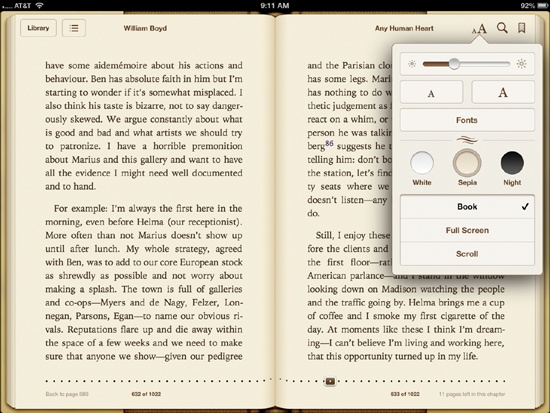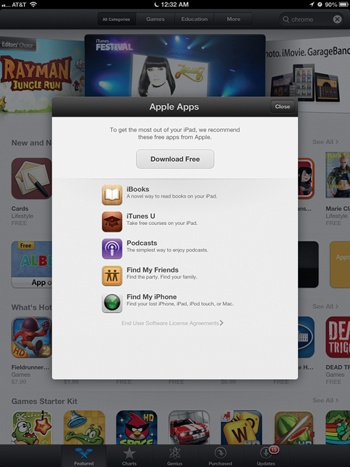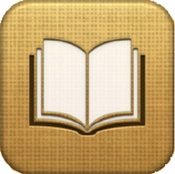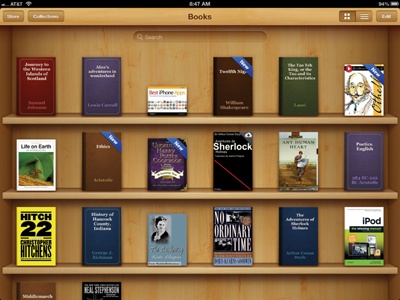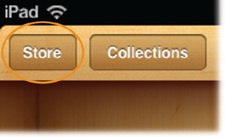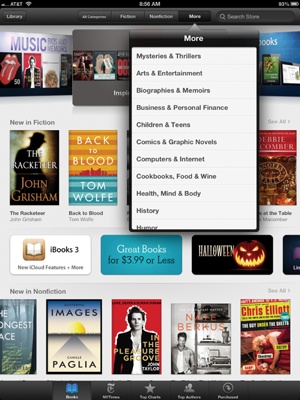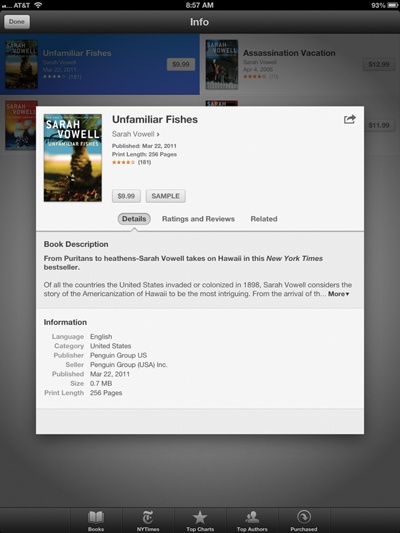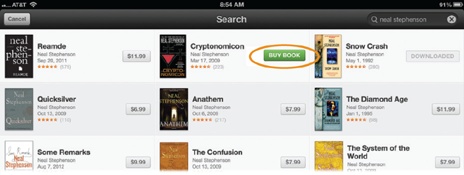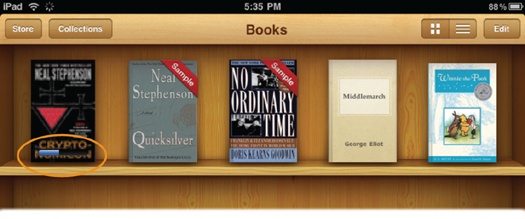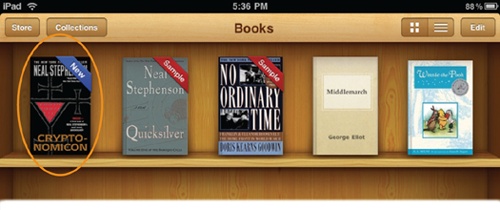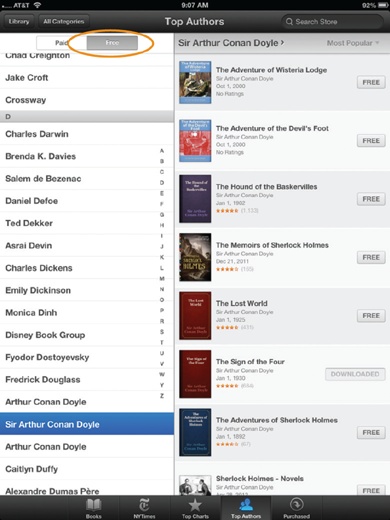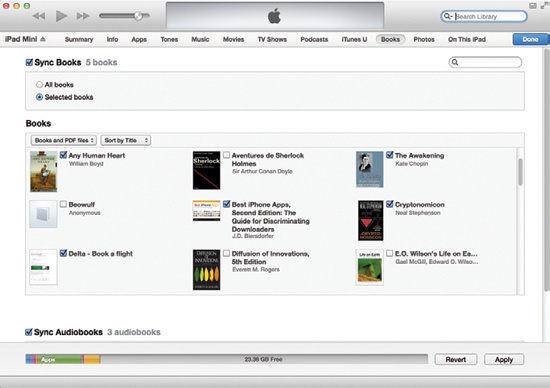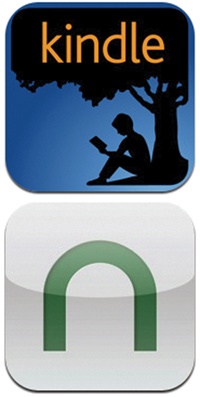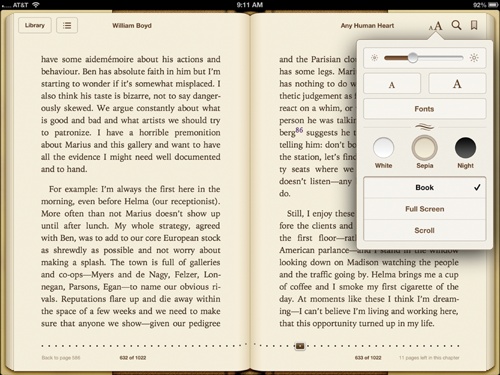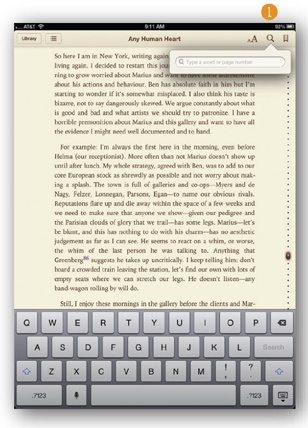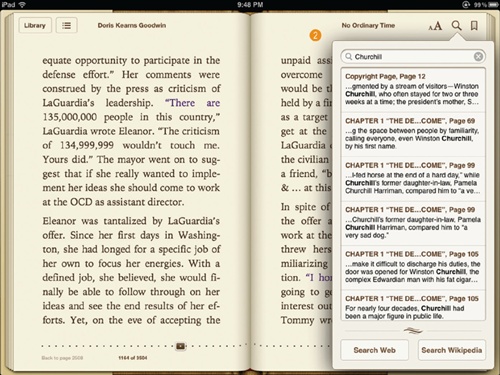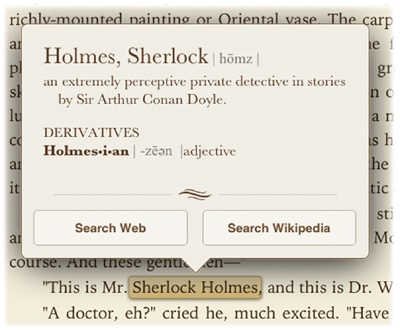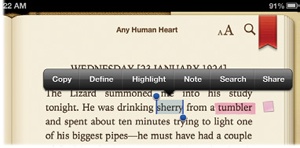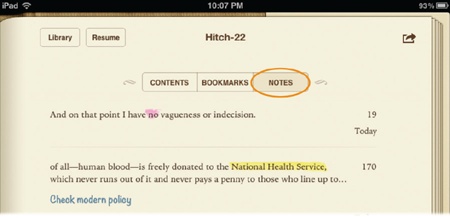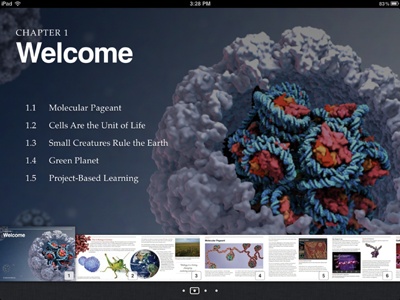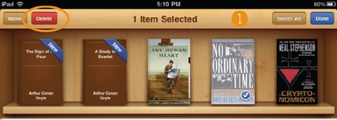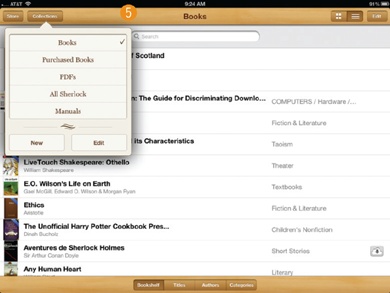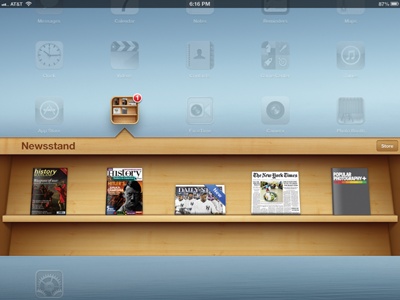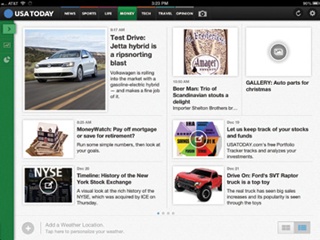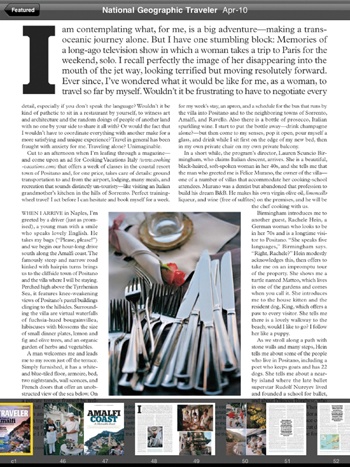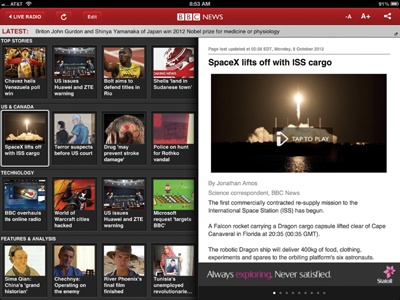Chapter 9. Read iBooks and ePeriodicals
You’ll learn to:
Buy books, magazines, and newspapers for your iPad
Find free books
Sync books across your devices
Copy audiobooks and PDF files to your tablet
Customize your books’ looks
BOOKS IN EASY-TO-USE, PAGE-TURNING form have been around since the second century or so. But now ebooks are wooing many people away from the world of ink, paper, and tiny clip-on book lights. Amazon’s Kindle Fire HD, the Barnes & Noble Nook, Google’s Nexus 7, and the Sony Reader are among the big names in the ebook/book-friendly tablet playground, but the iPad is right in there kicking it up as well.
With its high-resolution color touchscreen, the iPad takes the ebook experience to a new level. True, the Kindle Fire and Nook have color screens and the Fire is cheaper, but the iPad’s big bright display makes books, newspapers, and magazines look amazing.
The books themselves—especially Apple’s gorgeous iBooks textbooks—have evolved into interactive creations. Along with access to the iPad’s built-in dictionary, many iBook titles have searchable text, hyperlinked footnotes, and embedded margin notes and bookmarks that make the whole reading process more engaging and efficient. The latest version of iBooks (released in October 2012) even downloads updates to books—like corrected editions—automatically. So flip the page of this book to see how much fun you can have reading other books, as well as magazines and newspapers, on your iPad.
Download the iBooks App
BEFORE YOU CAN BUY and read an Apple ebook on your iPad, you have to do two things: recalibrate your brain, because Apple calls ebooks iBooks, and then pop into the iTunes App Store to download Apple’s free iBooks app. You can do that in a couple of ways.
On the iPad. Grab the iBooks app by tapping the App Store icon on the Home screen. You’ll probably see an alert box pop up inviting you to download iBooks and other Apple apps right off the bat (right). If not, you can always find the app yourself. You might see an iBooks icon on the App Store’s main page, or you can tap the Search box at the top of the screen, type in iBooks, and wait for the app to pop up. Then tap the Install App button.
On the computer. If your iPad is out of network range or you prefer to get all your apps via the desktop, you can snag iBooks through iTunes. Fire up the media manager, click the iTunes Store button, tap the App Store tab, and search for the iBooks app there. Once you download it, you need to sync your iPad with iTunes to install iBooks on your tablet. You can buy iBooks through the app (see the opposite page) or through the desktop iTunes Store and have them automatically sent to your iPad (see Use iTunes in the Cloud) or copied to it the next time you sync up (Sync Books Using iTunes).
Note
Did you jump right to this chapter because you really wanted to learn more about Apple’s approach to the whole ebook thing? If you’re feeling lost, flip back to Chapter 8. It gives you the lowdown on this App Store business and shows you how to open an iTunes account—which you need to buy books.
Go to the iBookstore
TO GET TO ALL the electronic books Apple has to offer in its iBookstore, you first have to open the iBooks app. Find it on your Home screen and tap it open. When the app unfolds, you’ll see a virtual rendition of a wooden bookshelf like the one below. This is where all your downloaded books eventually come to live.
These shelves are also known as your Library. Like a physical library, you come here whenever you want to pick out a new book. To get back to your virtual shelves from within a book or from a book’s detail page in the iBookstore, tap Library in the top-left corner.
Unlike the image above, your shelves start out empty—unless you’ve
purchased books on another iOS device; those appear with the
![]() icon on the cover that you can tap to download.
So how do you buy new books? As with other iPad apps, hit the Store
button. In the iBooks app, it’s in the upper-left corner (circled). As
for the Collections button here, once you get a bunch of books, you can
sort them into groups. Delete or Rearrange iBooks has
the details.
icon on the cover that you can tap to download.
So how do you buy new books? As with other iPad apps, hit the Store
button. In the iBooks app, it’s in the upper-left corner (circled). As
for the Collections button here, once you get a bunch of books, you can
sort them into groups. Delete or Rearrange iBooks has
the details.
Tap the Store button and, as long as you’ve got an Internet connection, you land in the iBookstore. Turn the page to find out what happens next.
Browse and Search for Books
ONCE YOU TAP IBOOKS’ Store icon, your iPad transports you into the iBookstore—which looks quite a bit like the iTunes and App Stores, but with books instead of music, videos, and TV programs. Browsing and searching work pretty much the same way, too.
The main storefront displays the latest releases. Tap the Fiction or Nonfiction buttons at the top of the screen to filter the selections. Tap the More button (shown below) to see a list of other categories; tap a category name to jump to it. The six icons at the bottom of the screen sort books in other ways:
Featured. This is the iBookstore’s main screen. It displays new and notable titles and spotlights genres. Flick to the bottom for links to books on sale, books on a theme, special book categories like Read Aloud books for kids, free books, and books so enticing that people are pre-ordering them. Buttons at the bottom of every Store screen let you log into or out of your Apple account, redeem iTunes gift cards, and get technical support.
NYTimes. This button reveals the weekly rankings of books on the venerable New York Times Best Sellers list, which has been charting books since 1942. The iBookstore’s version gets updated each week, in tandem with the Times’ list. (The author is an employee of the New York Times.)
Top Charts. Tap Top Charts to see a list of the most popular books people buy though their iPads, as well as a list of the most popular free books readers are snapping up (Find Free iBooks).
Top Authors. Tap here to see the bookstore’s inventory neatly organized by author name.
Browse. Tap the Browse button for a list of authors (alphabetically by last name) and categories to peruse. You’ll find lists for both paid and free titles.
Purchased. Tap here to see a list of your previous iBooks purchases—no matter where you bought them. Tap the All button to see everything, or tap Not On This iPad to see purchased titles missing from your tablet so you can download copies. (Want to automatically download your books to all your iTunes-connected devices? See Use iTunes in the Cloud.)
To search for a title or author, tap the Search box at the top of the Store screen. When the keyboard pops up, start typing in a book title or author name. The iPad returns a list of matching books. If the results aren’t what you wanted, tap the Cancel button in the top-left corner to quit the search.
Tap any cover to get more information—plot description, star ratings, reviews from other readers, examples of other books readers bought, and even a button to download a free sample of the work. You can also tap the price button to buy the book right away.
After you read a book, you can go back to its info page and offer your two cents about the story or writing. Tap the stars to give it a wordless ranking or tap the “Write a Review” link to give it a more thoughtful critique. You need to log in to your store account to rank and review books, so it’s not an anonymous undertaking.
In iOS 6, you can even brag on your discovery. Tap
![]() to email or Message an iBookstore link—or to post that link to your Twitter or
Facebook feed so your friends know what you’re reading.
to email or Message an iBookstore link—or to post that link to your Twitter or
Facebook feed so your friends know what you’re reading.
Buy and Download a Book
WHEN YOU FIND A book you simply must have in your digital library, tap the price button, which turns into a Buy Book button. Tap it, type in your iTunes/App Store/iBookstore account name and password so Apple has a credit card number to charge, and let the download begin.
Back in your iPad’s library—which you can always get to by tapping the Library button in the top-left corner of the Store screen—the book cover appears on the shelf. A blue progress bar (circled below) creeps across the cover to indicate how much of the book you’ve downloaded.
Most books take just a couple of minutes to arrive on your iPad, but this can vary depending on network congestion. When the download is complete, your book appears on your library shelf with a sassy blue “New” ribbon on the cover. (Free-sample chapters get a red “Sample” ribbon.)
Remember, if you bought iBooks on other iOS devices, you see their covers on your
shelf, too. Just tap the ![]() icon in the top-right corner of a book’s cover to
snatch a copy of it out of the sky.
icon in the top-right corner of a book’s cover to
snatch a copy of it out of the sky.
Find Free iBooks
MOST IBOOKS COST BETWEEN $6 and $15, significantly cheaper than the $25 to $30 you pay for the brand-new hardcover treeware versions. But the iBookstore isn’t all about the money, all the time. It offers more than a hundred absolutely free ebooks on its virtual shelves.
To find this Treasure Chest of Free Literature, go to the iBookstore and tap Top Charts. The Store lists free books on the right. To find a free book by author name, tap Top Authors at the bottom of the iBookstore screen. Then, at the top of the alphabetical list of authors, tap the Free button (circled below) and look for your author’s name. (Hint: Authors writing before 1923 often appear here.)
If you want to narrow your book choices beyond simply the free in either view, tap All Categories at the top of the screen and choose a topic. Tap a cover to read a synopsis and other readers’ reviews. Tap the Get Book button to download it; you can also get a sample of the book, but since the book itself is free, just go for it.
Most of the free titles are classic works of literature that have fallen out of copyright and into the public domain. In fact, you may have read some of them (or at least the Cliffs Notes guides) in school. The offerings include Middlemarch by George Eliot, The Art of War by Sun Tzu, Washington Square by Henry James, The Adventures of Sherlock Holmes by Arthur Conan Doyle, and many of Shakespeare’s plays.
You can also download Ulysses by James Joyce. Even though the big iPad weighs a pound and a half, it’s still probably lighter than paperback copies of this epic Irish novel of more than 700 old-fashioned printed pages.
Free books aren’t the fanciest ones on the shelf—on the outside, anyway. But while you don’t get colorfully designed mini book covers (they all look a bit plain), you sure can’t beat the price.
Sync Books Using iTunes
AS Chapter 12 EXPLAINS, iTunes is the traditional conduit for moving files between your computer and your iPad. True, you can always pluck a new copy of an iBook out of the iCloud if needed, or have your iPad automatically download the book over the air (Use iTunes in the Cloud). But what if you don’t have an Internet connection at the time, or you don’t want to use iCloud for whatever reason?
You can still back up your books to your computer by syncing your iPad with iTunes. And no matter how you copy your iPad’s contents, backups make for a much less stomach-churning event if you have to restore the tablet’s software (Start Over: Restore Your iPad’s Software) or if you accidentally delete a book you weren’t quite done with.
To sync your iPad with iTunes, connect the tablet to the computer via Wi-Fi Sync or USB cable. If you previously bought books on your iPad, choose File→Devices→“Transfer Purchases from iPad” to copy the books to iTunes.
Since your computer probably has more hard drive space than your iPad does, you can also use iTunes to sync books on and off the tablet as you need them, conserving iPad disk space. Click the iPad’s icon in iTunes, then click the Books tab at the top of the screen. Turn on the checkbox next to Sync Books. If you want to selectively sync titles, click “Selected books,” and then turn on the checkboxes next to the books you want. Click Apply, and then click the Sync button to make it happen. (You sync audiobooks this way, too.)
In addition to ebooks, the iBooks app also handles PDF files, like those that arrive as email attachments (tap the attachment and choose “Open in iBooks” at the top of the screen) or those you sync to your iPad by dragging them into your iTunes library. To find them on your iPad, fire up the iBooks app, tap the Collections button in the top-left corner, and then select PDFs from the menu.
Read Other Ebooks on the iPad
THE IBOOKSTORE ISN’T THE only place you can get electronic books. Bookstore behemoths Amazon and Barnes & Noble both have their own iPad apps that let you read the inventory from their online bookstores.
All you need is the official reader app (Kindle for Amazon and Nook for Barnes & Noble) and an account with the company so they can bill you for purchases—an existing Amazon or B&N account (with your payment info on file) will do fine. If you don’t have a purchase history with the company, point Safari to www.amazon.com or www.bn.com and sign up.
Fire up Safari to browse for and buy books from the companies’ websites. Once you do, open the relevant reader app on your iPad to sync your fresh purchases. Then tap a new book title to start reading. Each company conveniently provides a back-up copy of your purchases in your account.
You can download ebooks from the many book-download sites out there, too—type ebooks into your favorite search engine to find them. iBooks uses the popular ePub format for its digital books, so you can read any book that has the extension .epub—just make sure the file doesn’t have any fun-killing, copy-protecting DRM (digital-rights management) built in that requires a password before you can read it. Most ebook sites tag copy-protected books.
One place to get unprotected ePub files is the Project Gutenberg site. Founded in 1971, Project Gutenberg is a volunteer effort that collects and freely distributes great works of literature. To browse and download books from the collection, visit www.gutenberg.org.
You can search Project Guten-berg for specific books, which are often available in several file formats. Find a book in the ePub format (look for the extension .epub), and download it to your computer (right). To get the book onto your iPad, choose File→Add to Library in iTunes. When you get the file in iTunes, sync your iPad as described on the previous page. Once it’s on your iPad, it looks just like a regular iBook.
Read an iBook
OF COURSE, READING AN iBook isn’t the same as cracking open the spine of a leather-bound volume while you relax in an English club chair. But really—who reads books that way anymore (except characters on Downton Abbey)?
Reading books in the 21st century can involve anything from squinting through Boswell’s Life of Johnson on a mobile phone to gobbling down the latest Danielle Steel epic on the oversized Kindle DX e-reader.
Then there’s the iPad way. Tap open a book in your Library, and then tap one of its pages to see these controls:
Library. Tap here to leave your current book and go back to the iBooks bookshelf.
Contents. Tap this button to see the book’s chapter titles; tap a title to jump to that point in the book. Tap Bookmarks to see your list of bookmarks (Create Bookmarks and Margin Notes).
Buy. Reading a sample chapter? If you like what you read, tap Buy to get a near-instant acquisition for your library.
Page Navigator. Drag the little brown slider along the bottom of the page to quickly advance or retreat through a book’s pages. Keywords and page numbers flash on-screen as you drag the square in either direction.
The iPad displays books in either portrait or landscape mode (the latter shown across these two pages). Tap the screen in either view to make the iBook controls appear. Reading iBooks is probably the reason most people use the iPad’s Screen Orientation Lock (Use the Mute/Lock and Volume Buttons). Turning it on prevents your screen from spinning all over the place when you try to read in bed.
To turn the page in an iBook, tap the right margin to go forward and the left one to go backward. You can drag the page corner with your finger for that dramatic looks-like-a-real-page-turning animated effect, although you may find this slows down the action in the middle of a really good thriller. (Hate this faux-book look? Try the Full Screen or Scroll options instead—turn the page for more.)
Book Display. This button brings up a panoply of controls—for screen brightness, the size of the book’s type, its typeface, the background color of the page, and full-screen viewing. Turn this page for the lowdown.
Search. Tap the magnifying-glass icon (
 ) to get a search box where you can type in
keywords that you want to find in the book. The box also gives you
the option to search the Web and Wikipedia for more information
(Search an iBook).
) to get a search box where you can type in
keywords that you want to find in the book. The box also gives you
the option to search the Web and Wikipedia for more information
(Search an iBook).Bookmark. Tap here to save your place in a book; Create Bookmarks and Margin Notes has the details, along with info on writing margin notes.
Change the Type in an iBook
ONE THING YOU CAN’T do with a printed book is make the type size bigger or smaller to suit the needs of your eyes, not the book designer’s. And if you don’t care for a book’s typeface, you’re stuck with that, too—in a printed book, that is.
But not on the iPad. Thanks to the iBooks software, you can make book type bigger or smaller,
or change its look altogether. Just tap the Type icon
(![]() ) at the top of the page. A box like the one below
appears. Tap the little
) at the top of the page. A box like the one below
appears. Tap the little ![]() to make the text on-screen smaller, and the big
to make the text on-screen smaller, and the big
![]() to make the text bigger. The size changes as you
tap, so you see immediately which works best for you.
to make the text bigger. The size changes as you
tap, so you see immediately which works best for you.
To change the typeface (font) used for the text, tap the Fonts button in the box and tap the name of a typeface in the list that drops down. The font name appears in its namesake typeface so you can preview what it looks like on-screen. Tap the page when you’re done.
Hate reading on bright white pages? Adjust the screen brightness
by dragging the ![]() slider (this affects the iBooks screen only). To
change the page’s tint, tap the Theme button to see a drop-down menu
(shown open above) of the page backgrounds. Tap Sepia to give the page a
brownish tint, or Night to change to a black background with white
text—a good option for reading in bed without lighting up the
room.
slider (this affects the iBooks screen only). To
change the page’s tint, tap the Theme button to see a drop-down menu
(shown open above) of the page backgrounds. Tap Sepia to give the page a
brownish tint, or Night to change to a black background with white
text—a good option for reading in bed without lighting up the
room.
To discard the whole “virtual book” look, tap the Full Screen button to On to fill the iPad’s display with unadorned text. Tap the Scroll button to switch to Web-like page navigation where you flick through the text in one looooong page.
Search an iBook
NEED TO FIND A certain phrase in a book—or to see how many times a certain word appears in the text? The iPad helps you out here, too. You can start up a search two ways.
If you’re in the middle of a page, press and hold your finger down on a word you want to search for. A box appears over the word with four choices: Copy | Define | Highlight | Note | Search | Share. Tap Search and let the iPad bring you a list of results—in context (below).
And if you want more information about that searched word, the tablet offers buttons to search Google and Wikipedia, too. Let’s see that heavy hardback copy of The Casual Vacancy do that.
Use the Dictionary
READING A BOOK ON the iPad means you don’t need Webster’s Dictionary riding shotgun so you can look up word definitions. This sort of thing can help when you read scientific or historical texts, or if vocabulary was never your strong suit in high-school English class.
To see the meaning of a word, double-tap it (or press and hold it for a second) until the Copy | Define | Highlight | Note | Search | Share menu bar appears. For info about a full name or a phrase, drag the blue selection dots around the words. Tap Define to see the definition.
The dictionary recognizes some proper names, but as you see below, the results can return both real and fictional people.
Create Bookmarks and Margin Notes
EVEN IF YOU ABRUPTLY bail out of the iBooks app and jump to another program, the iPad remembers what book you were reading and what page you were on. If you happen to be reading a dense, brain-burning book and want to remember exactly where you left off (or you want to mark a passage for later reference), you can place a digital bookmark or highlight text right on the page.
To save your place, tap the bookmark icon (![]() ) in the upper-right corner. To mark a spot in the
text, double-tap a word to select it (or drag the blue selection dots
around more words). When the Copy | Define | Highlight | Note | Search |
Share box pops up, tap Highlight to swipe color across the
selected text or to underline it. Choose Note to make a digital Post-It
note in the margins. (You can also select, copy, and paste text in and
out of margin notes when you tap them open; see Cut, Copy, Paste, and Replace Text.) Tap Share to post the
selected text on Facebook, Twitter—or to mail it.
) in the upper-right corner. To mark a spot in the
text, double-tap a word to select it (or drag the blue selection dots
around more words). When the Copy | Define | Highlight | Note | Search |
Share box pops up, tap Highlight to swipe color across the
selected text or to underline it. Choose Note to make a digital Post-It
note in the margins. (You can also select, copy, and paste text in and
out of margin notes when you tap them open; see Cut, Copy, Paste, and Replace Text.) Tap Share to post the
selected text on Facebook, Twitter—or to mail it.
To see the notes you made, tap the Contents icon
(![]() ) in the top-left corner of the book’s page, and
then tap the Notes button (circled). You see a list of your notes—and
when you created them. Tap Bookmarks on the Contents page to jump to
that spot or tap Resume to go to the page you left, bookmarked or not.
Swipe a bookmark or note and tap Delete to remove it. Tap
) in the top-left corner of the book’s page, and
then tap the Notes button (circled). You see a list of your notes—and
when you created them. Tap Bookmarks on the Contents page to jump to
that spot or tap Resume to go to the page you left, bookmarked or not.
Swipe a bookmark or note and tap Delete to remove it. Tap
![]() to send the book’s Store link to friends, or to
edit your notes.
to send the book’s Store link to friends, or to
edit your notes.
Hate the text’s hue, red underlines, or highlighting? Tap the text
to select it and in the box that pops up, choose a different color by
tapping a dot. Tap the red-slashed circle to remove a highlight,
underlining, or note. At the end of the menu bar, tap the lined Note
icon to create and compose a new note. Tap ![]() to share the selected text by email or message,
on Facebook or Twitter, or to copy it for pasting elsewhere—like into a
school report. Finally, tap the
to share the selected text by email or message,
on Facebook or Twitter, or to copy it for pasting elsewhere—like into a
school report. Finally, tap the ![]() icon to get to iBooks’ Copy, Define, and Search
options.
icon to get to iBooks’ Copy, Define, and Search
options.
Use iBooks Textbooks
IF YOU THINK READING books on your iPad takes the weight off your shoulder and the clutter off your nightstand, just think of what it can do for people who have to read really heavy tomes—like high-school textbooks. Yes, the schoolbook market is getting a shot of iPad power, thanks to Apple’s new iBooks textbooks section, which arrived in January 2012.
Far from the weighty backpack-rippers of the past, this line of textbooks takes a standard subject, like algebra or biology, and presents it as a colorful, full-screen educational experience—complete with photos, videos, and interactive graphics. You can see what’s available by tapping the Store icon in the iBooks app, and then tapping Categories→Textbooks. Most textbooks cost less than $15.
These newfangled textbooks land right on your iBooks bookshelf once you make the purchase. Although the selection is still a bit limited, with fewer than two dozen titles available in the first few months, the project has the backing of major educational publishers like Pearson and McGraw-Hill.
As for digital textbooks in general, many colleges and universities started to make the shift to ebooks a few years ago, so students may also be able to find required texts in the general area of the iBookstore—especially for those comparative literature courses. Amazon and Barnes & Noble (Read Other Ebooks on the iPad) are also great sources of digitized textbooks on many subjects.
Delete or Rearrange iBooks
BIBLIOPHILES KNOW HOW EASY it is to amass piles of books and magazines. (Turn the page for more on magazines.) Magazines are usually emotionally easier to toss out, since they don’t have the feeling of permanence a book does. (On the iPad, you typically delete old issues from within the magazine or Newsstand app; see Use Newsstand for Your ePeriodicals.) But with books—well, some books you want to keep forever, while others, not so much—so let’s get some iPad drive space back.
If a book has to go—or go someplace else—here’s how you make that happen:
On the Bookshelf screen, tap Edit in the top-right corner. Tap the books you want to remove, affixing a virtual blue checkmark in the process. Tap the red Delete button, and then confirm the cuts.
You can also delete books through iTunes. Connect the iPad to your computer, click the Books tab, turn off the checkbox next to the unwanted titles, and then click Apply or Sync. iTunes removes the books from the iPad but keeps a copy of each for future reference.
Need to delete several books at once? The List View screen on the iPad is great for library management. To get to it, tap its icon (
 ). Then tap Bookshelf, and then the Edit
button. Tap the button next to each book you want to toss, and then
tap Delete at the top of the screen.
). Then tap Bookshelf, and then the Edit
button. Tap the button next to each book you want to toss, and then
tap Delete at the top of the screen.Now that you’ve pruned your literary holdings, you can do further tidying in List View. For example, use the grip strip (
 ) to drag existing titles into a new
order.
) to drag existing titles into a new
order.You can also organize your books into collections—say, all your British murder mysteries in one place. Select relevant books and tap the Move button at the top of the screen. A box pops up that lets you create a new grouping from the selected titles. Later, you get to the collection by tapping the Collections button at the top of the Library screen.
Use Newsstand for Your ePeriodicals
As you’ve probably gathered from this chapter, the iPad is a great way to haul around hundreds of hefty books in convenient electronic form. But what if you’re more into short-form reading, like Time magazine or The New York Daily News? The iPad makes getting hold of periodicals even easier. That’s because there’s an app called Newsstand right on your Home screen.
When you tap open the Newsstand app, you see some familiar-looking shelves. But tap the Store button on this Newsstand and your iPad whisks you to a special part of the App Store—one with electronic periodicals you can buy, subscribe to, and download.
The Store displays each ePublication as though it were an app, offering price, ratings, and other information. Tap a title to learn more about it, buy a single issue, or sign up for a subscription (see the next page for more on subscriptions). The bill for your purchases goes to the credit card linked to your Apple ID (Set Up an Apple ID).
If you sign up for a subscription for an ePeriodical with a Newsstand-friendly publication, the app automatically grabs each new issue and sends you a notification (if you have your settings configured to do so; see Use Notifications). The app also lists the number of new e-rags awaiting you in a red circle on the Newsstand icon. Tap it open to see what awaits you on your faux-IKEA shelves.
Subscribe to ePublications
AS YOU’LL DISCOVER ON the next page, some big news organizations don’t give content away for free. To get all the publication’s stories (and not just a Whitman’s sampler of summaries or selected articles) they may ask you to pay for a subscription. Here’s what to expect.
With some magazines subscriptions, you automatically pay for and receive a new version of the app (with new content) each month. When you subscribe to one of these titles, instructions guide you through the delivery and payment process. After you sign up for a subscription, your new issues are downloaded and neatly arranged on the virtual shelves of the Newsstand.
Apple processes subscription payments and renewals through the App Store. Many electronic magazines, like Wired, Elle, and Popular Science, are available, and some offer special interactive iPad features and content.
Subscribing through the App Store makes it easy to manage your subscriptions—they get billed to your Apple account, and you can renew or cancel your subscriptions right on the iPad. Here’s how:
Tap into the App Store from the Home screen.
Flick to the bottom of the screen and tap the Account button to log in.
Tap View Account and retype your password if asked.
In the box that appears, flick down to the Subscriptions area and tap Manage My Subscriptions.
Now you can see your subscription details and also turn off the Auto-Renewal setting (circled above). Remember, you’ll keep getting billed for a subscription until you cancel it here, so it’s good to keep tabs on your magazine tabs.
Tip
Magazines and newspapers aren’t the only periodicals you can read on your iPad—comic books look amazing on the big, bright screen. Just search the App Store for comics, and DC Comics, Marvel Comics, and the ComiXology’s Comics app (which has the big publishers and tons of indie titles, too) all pop up to save the day for superhero fans.
Find Newspaper and Magazine Apps
SINCE THE IPAD ARRIVED in 2010, its promise as a device for consuming periodicals has begun to pay off, especially with the introduction of the Newsstand app (Use Newsstand for Your ePeriodicals) to help wrangle those electronic publications on the Home screen. Most major news organizations have jumped on the tablet bandwagon.
In addition to some of the major outlets mentioned on these pages, many smaller publications now offer their own iPad apps. Search, and you can find college newspapers, sites like the International Business Times, and trade magazines like Crops (“the leading specialist journal for the arable farming industry”).
While some apps are basically the publication’s website reformatted for the iPad’s screen, other organizations have created beautiful apps that show off their content, complete with photos, videos, and audio. Some are free, some charge a fee just for the content, and some charge for the app and the content. You can find all the iPad-worthy news apps in the Newsstand or at App Store→Categories→News. Here are a few of the big ones:
The New York Times. This app offers the full daily paper, but you get only 10 articles for free; after that, you have to pay $20 a month for website and iPad access. The app offers up the day’s top stories in several categories, like Technology and Opinion. Tap a story summary to see the full story.
The Washington Post. Like its print counterpart, the app version of the Post covers daily life and the rough-and-tumble world of national politics in America’s capital. While it started out as a freebie, the company is considering the move to a paid-subscription model sometime in 2013.
USA Today. As colorful as its print counterpart, the Nation’s Newspaper wants to be the Nation’s iPad App, too. Along with the headlines, icons for checking sports scores and the local weather greet you when you open the app. Tap a section name at the top of the screen to jump to the Money, Sports, Life, Tech, Travel, and Opinion pages.
The Wall Street Journal. Since the early days of the Internet, the WSJ has been one of the few news sites on the Web to charge for full access, and its app continues the tradition. The app is free, and you can get a limited selection of stories when you register with the company. You sign up for a full-content subscription ($4 a week) with the Subscribe Now link in the bottom-left corner.
Zinio Magazine Newsstand. Want to browse a whole bunch of magazines and flip through a few before you buy? Try the Zinio app, which offers full-color sample pages from many printed mags (like The Economist, National Geographic, The Sporting News, and Cosmopolitan), all digitized and zoomable for your reading pleasure. The app and its samples are free, but the magazines themselves costs money. For example, one issue of Us Weekly is $3.99, while a yearly subscription is $67.
In addition to newsstand publications, news services—which often supply stories to some of those publications—also have great apps. All of those mentioned below include video clips of news events as well as text stories:
AP Mobile. The Associated Press compiles the day’s top stories into an informative stack of news boxes on the screen in this no-cost app (shown right). Tap a box to get the scoop. You also get photos and videos of the day.
BBC News. The British Broadcasting Corporation’s beautifully designed app neatly organizes the day’s stories in an easy-to-read, easy-to-navigate grid (shown below). Along with video clips, the Beeb—once and still a radio broadcaster—gives you a live radio stream with a tap on the Live Radio button at the top of the screen.
Reuters News Pro. With its quick access to the world stock-market charts and a built-in currency converter, this free app from the Thomson Reuters service is great for the financially minded. The app also showcases the top stories and photographs of the day.
Love news? The App Store also has apps from National Public Radio, NBC Nightly News, and international newspapers like Le Monde. You can also find apps that aggregate (collect) headlines from around the world. For people with a hearty information diet, the iPad pretty much offers an all-you-can-eat salad bar and buffet, but you do have to bring your own garlic bread.

